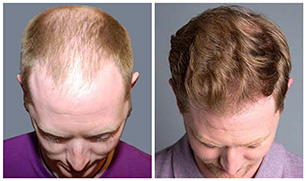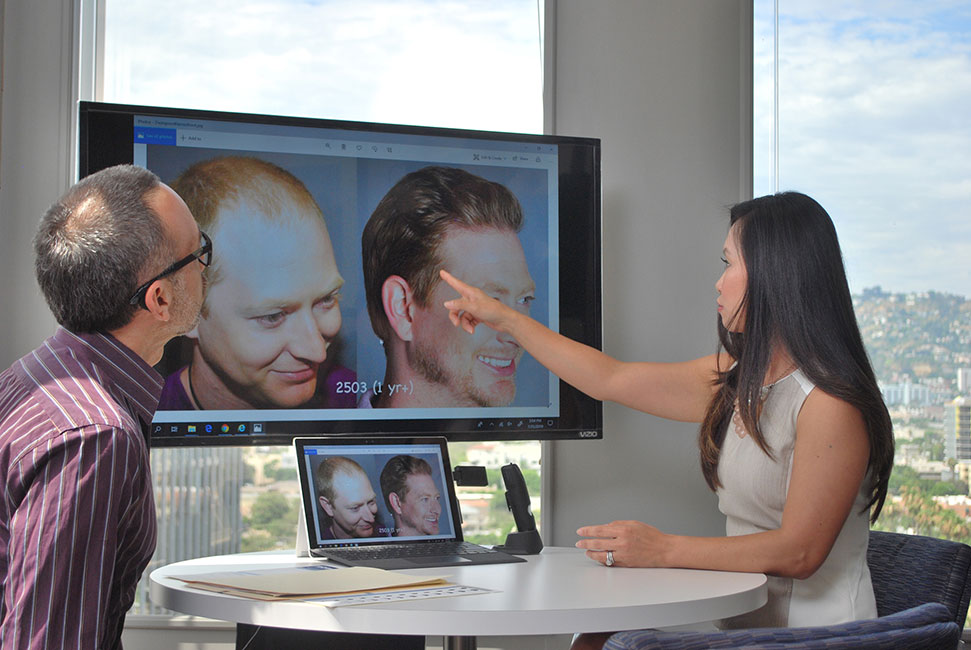Why Bosley FUT
At Bosley, we’ve put in the work to earn your trust. All Bosley FUT hair transplants are performed under the supervision of a Bosley physician. Our highly trained and experienced physicians have dedicated their practices to hair restoration, and that’s a primary reason why we are considered The World’s Most Experienced Hair Restoration Expert®.
Although our patients rarely need it, you also have The Bosley guarantee. For all hair transplantation procedures performed by Bosley physicians, we agree to replace any non-growing hair transplant grafts free of charge, providing the patient has adequate donor hair and meets the terms and conditions.
Benefits of an FUT Hair Transplant Procedure
The results are lasting and natural-looking
It’s your own hair and grows naturally
Follicle extraction is simple and quick
It can cover larger treatment areas
It offers the lowest chance for transsection thus providing more usable grafts
There’s no need for ongoing maintenance
It’s more affordable than other procedures
Who Is a Good Candidate for Follicular Unit Transplantation?
An FUT transplant is best suited for people whose primary goal is to address hair loss, severe thinning, or those who simply want to achieve maximum fullness. Men with androgenic alopecia, or male pattern baldness, make excellent candidates for FUT transplantation. Men with male pattern baldness tend to have an M-shaped hairline or a Norwood pattern.
An FUT hair transplant works best for people with more significant hair loss, as well as people who have high hair follicle density.
During your consultation, your physician will discuss whether follicular unit transplantation is right for you. You will need to provide your medical history so that the physician is aware of any medications you take and if you have had any medical procedures in the past.
What Does an FUT Cost?
The FUT hair transplant cost will depend on the number of grafts you will need, the size of the treatment area, and your individual goals. The majority of our procedures cost between $6,000 and $12,000. Plus, we offer 3rd party financing and low monthly payments.
Because we determine the cost of all procedures based on the number of grafts needed for your specific hair replacement needs, we encourage anyone interested in a FUT hair transplant to schedule a FREE, no-obligation, in-person or video consultation. Bosley also offers third-party financing to help you achieve a fuller, healthier head of hair.
Ultimately, the cost will vary from person to person. The best way to determine what your FUT surgery will cost is to contact our team of experts and schedule a consultation.
Follicular Unit Transplantation: An Affordable & Effective Solution
Follicular unit transplantation is a procedure that offers permanent results and a natural-looking, fuller head of hair you’ll love. According to the National Institutes of Health, FUT procedures can deliver a success rate of close to 95%.
When it comes to regrowing hair, FUT procedures are so effective because they use high-quality grafts, carefully prepared for strategic transplantation. The transplantation process includes the oil glands, or sebaceous glands, allowing the hair to continue growing as it naturally would.
During the surgical removal, the protective tissue around each follicle remains intact for maximum transplant success. The procedure is less time-consuming and less complex than other hair transplant options, which is reflected in the cost of FUT hair transplant procedures.
FAQs
How Should I Prepare for the FUT Procedure?
During your consultation with Bosley, we’ll discuss your medical history and any current medications to ensure a safe and successful transplant. If you’re currently taking hair loss medications, it’s recommended that you stop taking them for at least a few weeks before the procedure. The same applies to blood-thinning medications, though you should always consult with your primary care physician first.
It’s also important to stop taking any vitamins or supplements that can thin your blood, like fish oil. If you take antibiotics, you may also have to stop taking them before surgery (with the approval of your primary care doctor).
We recommend that you begin performing gentle head massages for at least ten minutes a dayleading up to your procedure. These massages can help stimulate hair follicles while also increasing your scalp’s elasticity.
Additionally, it’s recommended that you avoid excessive exposure to the sun and sunburns for at least two weeks before the procedure. Results are better when we operate on healthy skin without any sunburn or skin irritations.
What Can I Expect During Recovery?
Recovery time is generally short with minimal side effects. On the first night after your procedure, you may see some bruising or swelling in the recipient area. You’ll want to avoid touching or washing that area for the first few days. If you have to go outside, be sure to wear a head covering to avoid prolonged UV exposure. You should also sleep with your head elevated the first night to avoid disturbing any of the grafts.
We will provide you with post-operative hair wash and shampoo to use after the procedure. However, avoid washing your hair for three days after the procedure. When possible, patients are encouraged to come back for a professional hair washing the next day.
If you’re experiencing any discomfort, it’s perfectly safe to take over-the-counter medications like Advil. It’s important to be gentle with the recipient area for the first few days so that you do not disturb the grafts. If you experience any itching (which is a normal reaction to your scalp healing), gentle moisturizers designed for sensitive skin can help. You can always reach out to your physician with any questions or concerns about the recovery process.
In weeks two through four after the procedure, you may see transplanted hair begin to shed. This is normal, and you should continue washing your hair and styling it as usual. You will start seeing new hair growth in the recipient area after a few months.
Are There Alternatives to FUT?
Bosley offers one surgical alternative to FUT called follicular unit extraction, a process in which we remove individual hair follicles from your scalp and transplant them where you need them most.
A hair transplant procedure is the only way to fully restore a receding hairline. However, we also offer non-surgical options that can help slow the hair loss process, like BosleyRx finasteride treatment, which can help with overall thinning and reactivate growth. We also offer low-level laser therapy that can stimulate tissue molecules and blood flow to help regrow and strengthen your hair. Another non-surgical option we offer is scalp micropigmentation, which can give you the appearance of thicker, fuller hair.
Are There Any Risks or Side Effects Associated with Follicular Unit Transplantation?
Complications after an FUT procedure are extremely rare. You may experience mild scarring or inflammation of the hair follicles, called folliculitis, which can cause discomfort. In some cases, you may experience mild bleeding and soreness, but those symptoms will improve within a few days.







